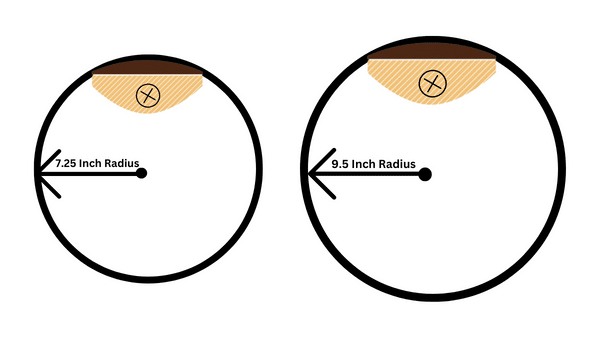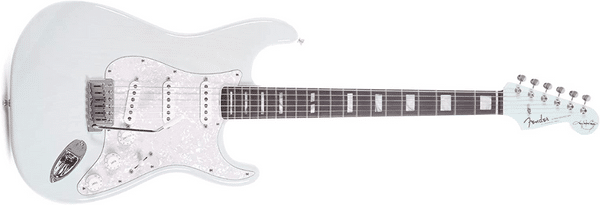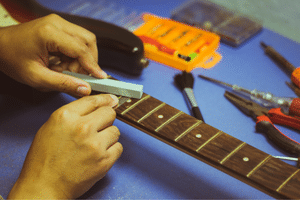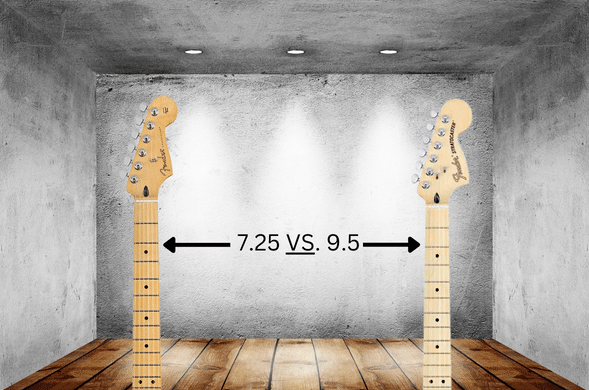A guitar’s playability is virtually defined by its neck! Guitarists can play for years without ever finding the “perfect neck.” In this article, I’ll reveal the difference between a 7.25 VS 9.5 inch fingerboard radius and which one might be best for you.
Keep on reading to learn more!
You can use the table of contents below to take you to the area that interests you. Click on the little box to open it, and then click on the section of the article you want to read, or you can read from start to finish if you want the full learning experience!
The Short Answer
When comparing a 7.25 to a 9.5 fingerboard radius, one is not clearly better than the other. A 7.25-inch fingerboard radius is more comfortable for chording notes but can be difficult to bend strings to hit the right note, especially when bending more than ½ step on the lower part of the neck. A 9.5-inch radius is more of an “all-around” fingerboard that accommodates chording and note bending all over the neck.
Choose the radius that feels most natural and works best for the style of music you play. Play as many different guitar makes and models as possible until you find the one that works best for you!
Keep On Reading (Below) To Learn More
What Is Fingerboard Radius?
First, you need to understand how fingerboard radius (also called fretboard radius) is measured and why it matters.
This image illustrates the principle, comparing a 7.25 to a 9.5-inch fingerboard radius neck.

As you can see, the amount of each fingerboard curvature is determined by the circumference of that circle’s radius, where the mid-point is lined up to the center of the neck. That’s really all there is to it!
So, the bigger the fingerboard radius, the flatter the fingerboard, and vice-versa!
Therefore, the 7.25-inch fingerboard radius would be more curved than the 9.5-inch fingerboard illustrated above.
Now that we’ve gotten that out of the way, we can get on to the more practical stuff!
Guitar Model Fingerboard Radius Comparison
To better understand what I’m talking about, check out this table that shows guitar models with a fingerboard radius of 7.25-inch and 9.5-inch. 12-inch radius guitars have been included for comparison purposes.
| 7.25-Inch Fingerboard Radius | 9.5-Inch Fingerboard Radius | 12-Inch Fingerboard Radius |
|---|---|---|
| Fender Vintage And Custom Shop Stratocasters & Telecasters | Fender American Performer Series | Fender Deluxe Series |
| Fender Brent Mason Telecaster | Fender American Professional II Series | Fender Player Plus Stratocaster |
| Fender Kenny Wayne Shepherd Stratocaster | Fender Vintera Modified Series | Gibson Les Paul Series |
| PRS Silver Sky | Fender Original ’60s Jaguar | Gibson SG Series |
The vintage fender guitars and Some of the Fender Signature series guitars (listed below) have a very curved (7.25-inch)fingerboard radius. In contrast, many of the newer Fender models have a flatter (9.5 or 12-inch) radius.
Gibson guitars generally have a 12-inch fingerboard radius.
Some guitars made for picking and tapping fast solos have an ever flatter fingerboard (15-inch or greater) or a compound radius fingerboard.
How Does The Fingerboard Radius Affect Playability, String Height, And Tone?
The fingerboard radius can affect a guitar’s performance all over the neck.
Playability
Essentially, more curved fingerboards make chord playing more comfortable, especially near the nut. Flatter fingerboards make it easier to bend single notes in all areas of the neck.
String Height (Action)
Generally speaking, flatter fingerboards can allow a guitar to be set up with a lower string height (action).
Tone
Fingerboard radius does not significantly affect a guitar’s tone, assuming the guitar is set up correctly. From a practical point of view, you won’t notice an effect on tone.
More Info
These concepts are summarized in the table below.
For additional info on playability, string height, and tone, see my article on 9.5 VS 12 Inch Fingerboard Radius – Which Is One Is Better?
What About Neck And Fret Size?
Neck
Various neck shapes and fret sizes can affect a guitar’s playability. Additionally, the overall size of a neck can affect guitar tone by changing the way it resonates when a string(s) is plucked.
Frets
Although the size and shape and each neck and fret type have their pros and cons, the most important factor is individual player preference!
More Info
These concepts are summarized in the table below.
For additional info on guitar neck and fret variations, see my article on 9.5 VS 12 Inch Fingerboard Radius – Which Is One Is Better?
Pros And Cons Of A Guitar Neck’s Specifications


This table should help you see the bigger picture when selecting a guitar neck. As you can see, it’s not just the fingerboard radius that matters!
| Consideration | Pros | Cons |
|---|---|---|
| Smaller Radius | More Comfortable to Play Chords | More Difficult to Bend Strings |
| Larger Radius | Easier to Bend Strings | Less Comfortable to Play Chords |
| Compound Radius | Best for Chords and Bending | Adds Cost to the Guitar |
| Smaller Fret Size | Harder to “Push” Note Sharp | Requires More Fretting Pressure |
| Larger Fret Size | Requires Less Fretting Pressure | Easier to “Push” Note Sharp |
| Neck Profile | “V, C, & Oval-C” ok for Small Hands | “D and U” worse for Small Hands |
| Smaller Neck Depth | Easier to Play with Small Hands | Can Have Less Tone and Sustain |
| Larger Neck Depth | Can Have Better Tone and Sustain | Harder to Play with Small Hands |
| Smaller Neck Width | Closer String Spacing | Harder to Play with Fat Fingers |
| Larger Neck Width | Easier to Play with Fat Fingers | Wider String Spacing |
Why I like 7.25-Inch Fingerboard Guitars
I have many guitars, some with curved fingerboards and others that are very flat. Each guitar design has its pros and cons, but I have a soft spot in my heart for my first early-70s Strat with a maple neck and a 7.25-inch rosewood fingerboard.
I find that it uniquely influences my playing style, especially when playing early-style blues. This fingerboard radius makes it more difficult to bend notes, especially in the first five frets, so I tend to favor quarter-tone string bends (half the distance of a one-fret bend).
The net result is that I tend to play with more feeling on a curvier fingerboard and find myself over-bending some notes on flatter necks, even with heavier gauge strings.
On the opposite side of that coin, I like at least a 9.5-inch fingerboard or flatter for high-octane Rock and Metal tunes. Flatter necks make me want to play faster with more finger tapping.
This is one of the advantages of owning more than one guitar. It won’t be long before you’ll want necks in a variety of fingerboard radius configurations!
Of course, what works for me might not be great for you, so you have to find your own way!
Who Makes The 7.25-Inch Neck Guitars?
So, What’s the deal with 7.25-inch fingerboard radius Fender guitars? Fender began producing them on their earliest solid body electrics, like the Broadcaster, turned Telecaster in the late 40s and the Stratocaster in the early ’50s.
Fender used the 7.25-inch fingerboard right up until the 80s when they “modernized” their fingerboards with a flatter 9.5-inch radius, which were more “Rock and Metal friendly.”
Over the years, Fender guitars have been designed with progressively flatter fingerboards, and the 7.25-inch models have become less and less popular.
These days, not many, if any, low-to mid-price Fender guitars are available with the 7.25-inch option.
Gibson traditionally went with a 12-inch fingerboard radius for the solid-body electrics, like the Les Paul and the SG.
Fender “Signature Series” Guitars
Fender offers these “Signature Series” artist guitars with a 7.25-inch radius:
- Brent Mason Telecaster
- Chrissie Hynde Telecaster
- Jason Isbell Custom Telecaster
- Jimmy Page Telecaster
- Kenny Wayne Shepherd Stratocaster
- Albert Hammond Jr Stratocaster
- Johnny Marr Jaguar
My favorite Tele of the bunch is the Jimmy Page “Dragon” model (think Led Zeppelin I album). You can check this bad boy out on Amazon if you’re interested in learning more:

My favorite Strat on the list is the Kenny Wayne Shepherd model. I love the sound of the swap ash body! Here’s the Amazon link if you’re curious:

Non-Fender Signature Series 7.25-Inch Guitars
Alternatively, you can buy a real Fender vintage guitar or have the Fender Custom Shop build you one. Either way, it’s a pricey proposition!
Some “non-Fender” 7.25-inch fingerboard options include the Paul Reed Smith (PRS), John Mayer Silver Sky (non-SE model), and the Yamaha PAC1611MS (Mike Stern Signature model).
Can You Change The Neck On Your Guitar?
Yes, you can change the neck on some guitars, but there are some limitations you need to be aware of.
The most important thing to remember is that the scale length of the original and the replacement neck must be the same! For example, you can’t put a 24+3⁄4 inch neck on a guitar that has a 25+½ inch neck.It won’t sound right because the intonation will be off.
Neck changes can be done relatively easily with bolt-on-neck guitars.
Swapping a glued-in neck is hardly ever done unless the original neck is damaged beyond repair. It requires a luthier (guitar builder) to do it right and is usually cost-prohibitive.
Neck-through-the-body guitars cannot be changed-out because the body is glued onto both sides of the neck.
Players usually change out a neck to have one with a different fingerboard radius and fret size. If the radius is ok, you may be able to keep the neck and replace the frets with smaller or larger ones.
If you are going for a re-fret, oftentimes, the fingerboard can be reshaped to change the radius.
It can be cheaper to buy a replacement neck than to make fingerboard and fret modifications.
You could permanently damage your guitar during a neck modification if you do not have the proper tools or training. Take the guitar to a certified technician or luthier!
Are You Qualified To Make Guitar Adjustments Or Modifications?

It’s great to work on your guitars, especially if you have a lot of them, but you should always be aware of your limitations.
Adjusting things like an electric guitar’s string height (action) or pickup height can be straightforward. Still, some adjustments require the proper training and experience, like doing work on your guitar’s neck or adjusting its truss rod.
When you doubt your ability to adjust, repair, or modify your guitar, it’s always best to bring it to a competent guitar technician or luthier (guitar designer & builder). You can permanently damage your guitar, and it might never play and sound right again!
Making modifications to your guitar can void its manufacturer’s warranty and cause permanent damage to the instrument. Certain modifications are irreversible, so you may be stuck with them, even if you desperately want to restore the guitar to its original condition!
I learned that the hard way over the years until I did a three-year apprenticeship in a guitar repair shop. Now I have my own home workshop with the proper training and equipment to safely maintain and repair all my instruments.
Remember: “When In Doubt, Send It Out!”
Frequently Asked Questions

Here are some of the questions I get asked about guitar necks.
If your question does not appear here, please put it in the comments, and I will get right back to you with an answer.
Why Do Guitar Necks Have A Radius?
The purpose of a fingerboard radius is to make the guitar neck feel more comfortable in the hand when fingering the strings and moving up and down the fingerboard. Each player may find a particular fingerboard radius and neck shape more comfortable than others, depending on hand size, playing style, etc.
How Do I Know The Radius Of My Guitar Neck?
You can get an approximate idea of how curved your fingerboard is by glancing at it from the side. If you would like to know the actual size, look in the booklet that came with your guitar or find the neck specifications online. To measure the radius for yourself, you need to place a radius gauge on top of the fingerboard.
Is A Compound Radius Neck Better?
Generally speaking, a compound radius neck gives you the best of both worlds. The fingerboard radius is the smallest near the nut for comfortable note chording and progressively widens toward the opposite end for easier soloing.
Is A Wider Neck Easier To Play?
No, not really, especially not for players that have small hands. The wider string spacing makes moving your fingers from string to string more challenging. Wider necks may feel more comfortable for players with fat fingers.
What Makes A Guitar Neck Fast?
“Fast” guitar necks typically have a flat (bigger radius) fingerboard with larger (wider and taller) frets. The string height (action) is set as low as possible without having string buzz or “fret-out.”
What Is The Purpose Of A Fingerboard?
The fingerboard is shaped (radiused) with a curve that helps makes the neck comfortable to play. The strings are pressed down on the fingerboard to make notes ring out. Notes have a lower pitch near the nut and get higher as you move toward the guitar body.
Final Thoughts

I hope you enjoyed this article on the differences between a 7.25 VS 9.5 inch fingerboard radius and that you found it helpful in choosing your first or next guitar!
When it comes to fingerboard radius, neither 7.25 nor 9.5-inch is clearly better. It depends on your guitar design, playing style, music genre, and hand size.
Fingerboard radius can affect the feel and playability of a neck in several important ways.
Guitarists who play rhythm guitar or simple melodies on the lower part of the neck usually find a 7.25 fingerboard radius more comfortable than a flatter neck. I find that my guitars with this neck radius help prevent me from “over-bending” notes.
Since flatter fingerboards have become more popular, finding guitars with a 7.25-inch fingerboard radius is becoming progressively more difficult. Necks with this radius are available on various Fender Signature series guitars, vintage Strats and Teles, and Fender Custom Shop models.
Generally speaking, a 9.5-inch fingerboard has more of an “all-around” feel, making chording notes comfortable on the lower end of the fingerboard and accommodating string bending up toward the guitar’s body.
A larger fingerboard radius usually allows a guitar to be set up with a lower action (string height).
Fingerboard radius has minimal, if any, effect on tone. Very big (thick) necks can improve tone and sustain.
The best way to find the ideal fingerboard radius is to play as many different makes and models of guitars as possible. For example, Fender guitars can play very differently than Gibson or Ibanez models.
Other Factors To Consider
Compound radius necks can offer the best playing comfort, note chording, and sting bending. They are more challenging to manufacture than a straight radius neck and may significantly increase the price of a guitar.
The shape of a guitar neck works together with the fingerboard radius and fret size to define its playability.
A guitar with a bolt-on neck can usually be swapped out for a neck with the same scale length. Do not attempt this if you don’t have the proper tools and training.
Have A Look At This Video
Here’s a great video from the Fender Custom Shop, where master builder Dennis Galuszka talks about how to select a neck shape. Check it out. It covers a lot of great info!
Related Article ➡ When To Buy Your Second Guitar? (With Buyer’s Guide).
Related Article ➡ 9.5 VS 12 Inch Fingerboard Radius – Which Is One Is Better?
Tell Me What You Think

Please leave a comment below if you enjoyed this article, have any questions about fingerboard radius, or want to give your point of view. I will be happy to help you.
- Do you prefer a 7.25 or a 9.5-inch radius? Why?
- Would you be willing to pay extra for a guitar with a 7.25 radius neck?
- Do you favor playing a single guitar or having others with different necks?
- After reading this article, do you know which fingerboard radius is best for you?
- What else is on your mind?



Hey, great article on the 7.25 vs 9.5 inch Fingerboard radius. I must admit that during my over 50 years of guitar playing I have never encountered any information about Fingerboard radius. Wow, hard to believe. I found this post very informative.
I started out with an electric guitar in my late teens and early 20’s and 30’s, playing in a few different bands over the years. In the 1970’s I went to school and studied classical guitar and music theory for 4 years.
I taught classical guitar for over 20 years. Recently, in my 70’s now I wanted to get an electric guitar again. Maybe wanting to relive my youth, haha. So, I found a Fender Strat Squire along with a studio sized Fender amp on Kijiji at an affordable price. So, here I am now trying to remember a lot of what I used to play.
I have bookmarked your site and will return often for more tips and advice. Like they say, “You are never to old to learn”.
Thanks again…
Hi, William
Thank You for your comments and compliment! I really appreciate them.
I’m thrilled that you enjoyed the article! Have you seen my other article on “9.5 VS 12 Inch Fingerboard Radius – Which One Is Better?”
We are always learning new things, which helps us advance our knowledge and playing ability.
It sounds like you are quite an accomplished player!
I love that you bought a Strat Squire and a studio amp! Revisiting the music of your younger years can be very rewarding, and I do it all the time! Also, there’s so much more happening these days with modern Rock, Blues, Country, Metal, etc.!
I’m sure you’ll be tremendously successful with whatever you choose to play!
Please comment again!
Best, and Keep On Playin’!
Frank 🎸
Frank I have a general question regarding learning to play the guitar. I am a country music lover and a farmer. I have always wanted to pay the guitar but have also always felt I don’t have a musical bone in my body. In your opinion, when is it too late to start learning a musical instrument, specifically the guitar?
Hi, Ali
Thank You for your comments!
I can’t tell you how many times I’ve heard people say, “I don’t have a musical bone in my body,” and “I’m just too old to learn to play.”
My answer to you is that ANYONE can learn to play the guitar or any other instrument, and it is NEVER too late to start playing!
Get yourself a guitar, if you don’t already have one, and get to work, BUT be sure to make it fun!
If you are looking for an electric guitar, I would recommend getting a Fender Telecaster, which is the guitar model most country players use because it has that “country twang.” If you want an acoustic guitar, anything will do.
It’s easier to learn on an electric guitar because they have thinner strings and play easier than acoustic guitars. Either way, you don’t have to spend a lot of money on your first instrument. So, get yourself started, and you’ll be glad you did!
It’s very cool that you are a farmer! 😎
Best,
Frank 🎸
I just recently played the House of Blues at the age of 44. My first guitar was purchased 3 weeks (advanced present) before my 31st birthday. I have a student I teach guitar to that is 61 years old and will soon be able to join me for a local jam night.
It’s never too late. And, learning an instrument is more about practice and perseverance than it is about having “musical bones”. If you want to be able to strum “cowboy chords” along to your favorite tunes around a campfire, anyone can do it if they put the work in. Whether they are 13 or 73 years old.
Tomorrow night, my local modern Country band (we play Luke Combs, Jason Aldean, etc.) is playing a show on Veteran’s day! Being a Marine vet who served in Iraq, I cannot wait for the show. I am the lead guitarist in the band.
Remember, I got my first guitar at basically 31 years old, and I am 44 now.
I recommend to buy a guitar that you will love and inspires you to keep playing. Don’t waste your money on something cheap. Dive in and get something warm and magical. Higher end guitars hold their resale value well.
Cheers and best of luck!
Hi, Ryan
Great reply!
Happy Veterans Day and Thank YOU for your service! ?? ?
Frank ?
Thanks for the all the great info, Frank! I just picked up an all original ’79 American Standard Strat. It’s so different than all my other guitars. I am already noticing the difference in high e string bends! 🙂
Hi, Ryan
Congrats on scoring an excellent axe! Late 70s American Standard Strats really rock! I love the necks on them.
Have big fun with it! ?
Keep On Rockin’ ?
Frank ?
Frank, great explanation on the 7.25 vs. the 9.5 radius comparison. I’ve seen the numbers all my life and never dove deep enough to fully understand the characteristics. I always went with “feel” and sound as I shopped at the brick and mortar music stores in the past. Now with on-line shopping more prevalent, it’s a little more important to engage with specifications listed in the descriptions. Your article provides lots of “food for thought” considerations before making a purchase. I’m 76 and have been playing for about 60 years and don’t ever intend to stop playing……and it’s never to late to start playing guitar. Thanks again for your enlightening article.
Hi, Chuck
Thank You so much for your kind words!
All the fancy explanations of fingerboard radius aside, the best neck is the one that feels and plays best in your hand! I’m sure you realize that with all your years of musical experience. ?
Your guitar-playing time is totally awesome! I’m 68 years old and have been playing for over 50 years.
You must have seen some amazing performers and vintage equipment over the years. Do you have any vintage guitars and amps?
God willing, we’ll both play guitar for many years to come!
Rock On! ?
Frank ?
Unfortunately…..not anymore. When you are young you do some pretty stupid things and I have ad my share of those moments. The two biggest examples were a 57 Les Paul gold top and a 64 Fender Vibroverb (15 “speaker) made for only one year. Yes, could still kick myself in the butt, but many of us have gone down this road for sure. I still have an American made 60th Anniversary Strat and a couple of Squire Tele’s and MIM P-Bass. I have to admit the Squires are pretty darn nice to play.
Hi, Chuck
Wow! A ’57 Gold Top with Vibroverb? Awesome vintage gear!
The Squier series are made pretty well, and I’ve seen some pros use them onstage!
I’ve modded a few guitars in my day that I should have left alone, like a ’69 Strat that I turned into a shred guitar by upgrading the pickups and tremolo bridge.
Even the dumb things we do can be part of the fun of playing the guitar.
It sounds like you’re still having a good time, and that’s all that really matters!
Keep On Rockin’!?
Frank ?